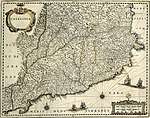Commonwealth of Catalonia
Commonwealth of Catalonia | |||||||||||||||||||||
|---|---|---|---|---|---|---|---|---|---|---|---|---|---|---|---|---|---|---|---|---|---|
| 1914–1925 | |||||||||||||||||||||
| Capital | Barcelona | ||||||||||||||||||||
| Common languages | |||||||||||||||||||||
| Government | Federation of provinces | ||||||||||||||||||||
| President | |||||||||||||||||||||
• 1914–1917 | Enric Prat de la Riba (first) | ||||||||||||||||||||
• 1924–1925 | Alfons Sala (imposed) (last) | ||||||||||||||||||||
| Historical era | Bourbon Restoration | ||||||||||||||||||||
• Established | 6 April 1914 | ||||||||||||||||||||
• Primo de Rivera coup d'état | 13 September 1923 | ||||||||||||||||||||
• Disestablished | 20 March 1925 | ||||||||||||||||||||
| |||||||||||||||||||||
The Commonwealth of Catalonia (Catalan: Mancomunitat de Catalunya, IPA: [məŋkumuniˈtad də kətəˈluɲə]) was a deliberative assembly made up of the councillors of the four provinces of Catalonia. Promoted in its final stages of gestation by the Regionalist League of Catalonia, it was strongly endorsed by municipal referendum in October 1913.[1]: 8
The Commonwealth was created in 1914 (symbolically the 200th anniversary of the year of the loss of governing institutions independent of the Spanish central administration) and was disbanded and outlawed in 1925 during Miguel Primo de Rivera's dictatorship.[2]
Although it had only administrative functions and its powers did not go beyond those of the provincial councils, it had great symbolic and practical importance: it represented the first recognition by the Spanish State of the identity and territorial unity of Catalonia since 1714.[3][1]: 19 and was responsible for the creation of many public institutions in health, culture and technical education and science and notably for the support of the Catalan language.[1]: 9
History

The lower house of the Spanish Parliament approved the creation of a Commonwealth but with limited powers compared to those originally envisioned for it by its promoters. The Spanish Senate never approved the creation of the authority. On 18 December 1913 the king signed the law granting all Spanish provinces the right to group themselves into associations or commonwealths. Catalonia was to prove to be the only commonwealth so formed.
The first President of the Commonwealth of Catalonia was Enric Prat de la Riba and the second was the architect Josep Puig i Cadafalch, both of the Lliga Regionalista, who led a programme to create an efficient infrastructure of roads and ports, hydraulic works, railways, telephones, charities and healthcare. The Commonwealth also undertook initiatives to increase agricultural and forest yields, introducing technological improvements, the improvement of services and education, and promoting education in technologies necessary for Catalan industry.
The Commonwealth was dissolved and outlawed under Miguel Primo de Rivera's dictatorship on 20 March 1925.[3]
Structure
The Assembly of the Commonwealth was initially made up of 36 for councillors from Province of Barcelona and 20 from each of the Provinces of Tarragona, Girona and Lleida) and elected Enric Prat de la Riba, leader of the Regionalist League, as president of the Commonwealth on 6 April 1914. In addition to the assembly and the president, the Commonwealth included an Executive council made up of 2 councillors from each province.[2][3]
Legacy
| History of Catalonia |
|---|
 |
| Timeline |
The Commonwealth created and consolidated a set of cultural and scientific institutions (most of which still exist today) to give greater prestige to Catalan language and culture, such as the Institut d'Estudis Catalans (Institute of Catalan Studies), the Biblioteca de Catalunya (Library of Catalonia), the Escola Industrial (Industrial School), the Escola Superior de Belles Arts (College of Fine Arts), the College of Higher Commercial Studies or the Escola del Treball (College of Industry). Prat de la Riba also created, the Escola de l'Administració Local (School of Local Administration), and required Catalan civil servants to have attended this institution.
Another important effort of the Commonwealth was the promotion of the work of Pompeu Fabra, who was chiefly responsible for the current Catalan writing system and linguistic standard.
On 25 January 1919, the Commonwealth approved a draft Statute of Autonomy. This Statute envisaged an autonomous government made up of a parliament, an executive and a governor-general, defined an autonomous financial framework and delineated the powers of the state and a government of Catalonia. The draft was rejected by the Spanish government, but it remained a point of reference for the drafting of the 1932 Statute of Autonomy.[4][5]
References
- ^ a b c Balcells, Albert, ed. (2015). La Mancomunitat de Catalunya (1914); centennial symposium (in Catalan). Barcelona: Institut d'Estudis Catalans. ISBN 978-84-9965-252-8. Retrieved 10 June 2019.
- ^ a b "Towards autonomy: the Commonwealth of Catalonia, 1914–1925". Retrieved 15 June 2019.
- ^ a b c "Mancomunitat de Catalunya" [Commonwealth of Catalonia]. Encyclopedia Catalana (in Catalan). Grup Enciclopèdia Catalana. Retrieved 15 October 2012.
- ^ Molas Batllori, Isidre (1983). "El Projecte d'Estatut d'Autonomia de Catalunya" [The design of the Statute of Autonomy of 1919] (PDF). Recerques: Història, economia, cultura (in Catalan). 1983 (14): 69–79. ISSN 0210-380X. Retrieved 15 June 2019.
- ^ "Beginnings of the autonomous regime, 1918–1932". Generalitat de Catalunya. Retrieved 15 June 2019.
External links
- "Mancomunitat de Catalunya Exhibition". 2014. Retrieved 15 June 2019.


